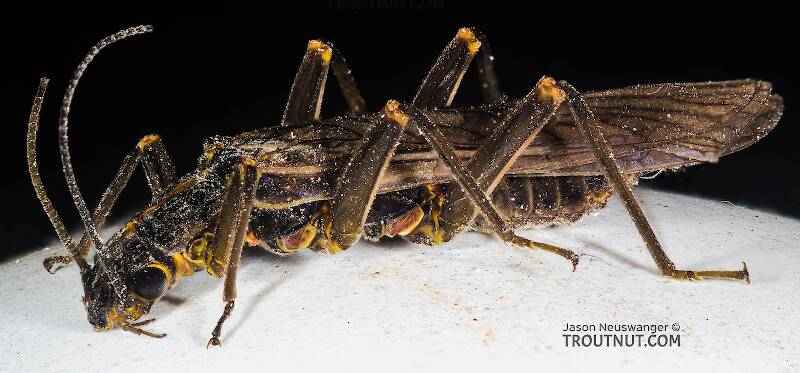
Salmonflies
Pteronarcys californica
The giant Salmonflies of the Western mountains are legendary for their proclivity to elicit consistent dry-fly action and ferocious strikes.

Mayfly Species Leptophlebia intermedia (Black Quills)
Species Range
Physical description
Most physical descriptions on Troutnut are direct or slightly edited quotes from the original scientific sources describing or updating the species, although there may be errors in copying them to this website. Such descriptions aren't always definitive, because species often turn out to be more variable than the original describers observed. In some cases, only a single specimen was described! However, they are useful starting points.
Male Spinner
Wing length: 8-13 mm
A rather small species, distinguished from all others except B. grandis (now a synonym of L. intermedia) by the distinctive “scarf” type of penes.
Frontal margin of head red-brown; vertex and notum of thorax blackish. Sternum deep reddish black. Pleura dark red-brown with black markings. Fore leg red-brown (orange, in recently transformed specimens), tarsus slightly paler than femur and tibia. Venation orange to reddish brown; no stain at wing roots or in stigmatic area. Abdominal tergites dark red-brown, sternites more yellowish. Ganglionic areas orange; sternite 9 reddish brown. Usual pale oblique submedian streaks on tergites, dark markings at spiracles, and faint dark oblique submedian streaks on sternites. Middle tail fully 2/3 the length of the laterals. Tails dark red-brown, joinings obscurely darker. Penes much as in B. grandis, with the appendages extending backwards almost to end of notch (see fig. 138).
Described as B. grandis
Body length 11-13 mm, wing length 10-13 mm
This is a rather large species of lighter brown color, alternately yellowish brown. Thorax above shining brown with yellow streaks in the notal furrow each side. Legs dull yellow with the tarsi a little paler and the usual lines on the knee caps very narrow. Wings yellowish in front and toward the outer margin; hyaline at the center and toward the rear; hind wings white.
Abdomen pale yellowish brown, paler beneath especially in the middle of the segments. Segments 1 to 6 have the mid-dorsal pale line almost entire, and the paired oblique marks confluent with the pale rings at the base of the segments. The latter give the abdomen a distinctly ringed appearance. The dorsum of 7 to 10 brown, practically without color pattern. Tails white, distinctly ringed with reddish brown. Genitalia as in fig. 138.
This species is larger and paler than others of the genus; the ‘“scarf” type of penes is found only in this species and in B. intermedius (now a synonym of L. intermedia).
Start a Discussion of Leptophlebia intermedia
References
- Needham, James G., Jay R. Traver, and Yin-Chi Hsu. 1935. The Biology of Mayflies. Comstock Publishing Company, Inc.
Mayfly Species Leptophlebia intermedia (Black Quills)
Species Range
Resources
- NatureServe
- Integrated Taxonomic Information System
- Global Biodiversity Information Facility
- Described by Traver (1932)


